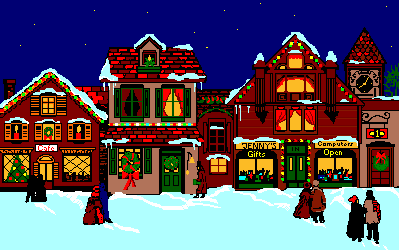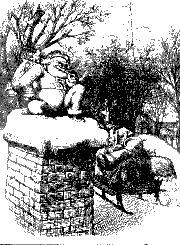

Christmas wasn't celebrated by the early church until the fourth century. In the fourth century, the church decided to try to redeem a Roman pagan winter solstice festival: the festival of Saturnalia. This December holiday was considered the "birthday of the unconquered sun." Romans danced in the streets with gifts under their arms and greenery atop their heads.
Based on Biblical evidence Jesus of Nazareth was probably born in the fall near the Jewish feast of Tabernacles or in the spring around the time of Passover. Sometime before 336 the Church in Rome, unable to stamp out the pagan festival of Saturnalia, spiritualized it as the "Feast of the Nativity of the Sun of Righteousness." December 25th was chosen for the celebration of his birth by Pope Julius I. The practice was adopted by the Christian church in Antioch around 374. By 380 it was being observed in Constantinople, and by 430 in Alexandria. (The New International Dictionary of the Christian Church, p. 223.)
Germanic tribes of Northern Europe also celebrated mid-winter with feasting, drinking, religious rituals and the lighting of the yule log. During the Middle Ages, Catholic priests sought connections between biblical teachings and pagan traditions - believing that a convergence of customs would lead more individuals to Christianity. The celebration of Jesus' birth was melded into other age-old practices and became known as the "Christ mass." Firelight represented the light of Christ. Gift giving was linked to the presents of the wise men. Trees were decorated with apples associated with the biblical Garden of Eden.
The tradition of decorating trees occurs among many different people. The Celts for example decorated trees with apples and nuts during the winter solstice (around December 21), encouraging the sun to return to bring spring. Other European people had tree decorating rituals.
In the 7th century a monk from Crediton, Devonshire, went to Germany to teach the Word of God. He did many good works there, and spent much time in Thuringia, an area which was to become the cradle of the Christmas Decoration Industry. Legend has it that he used the triangular shape of the Fir Tree to describe the Holy Trinity of God the Father, Son and Holy Spirit. The converted people began to revere the Fir tree as God's Tree, as they had previously revered the Oak. By the 12th century it was being hung, upside-down, from ceilings at Christmastime in Central Europe, as a symbol of Christianity.
 The first
record of the Christmas tree (as we know it) dates back to Riga in Latvia, in
1510. In the last quarter of the 16th century, Martin Luther is said to have
decorated a small Christmas Tree with candles, to show his children how the
stars twinkled through the dark night. Decorated trees became very popular
during the German Yuletide. In 1841, Queen Victoria of England married Prince
Albert of Germany. Albert brought the Christmas tree custom to England and
hence, to the English speaking world. Many citizens were eager to embrace the
traditions of the English royalty.
The first
record of the Christmas tree (as we know it) dates back to Riga in Latvia, in
1510. In the last quarter of the 16th century, Martin Luther is said to have
decorated a small Christmas Tree with candles, to show his children how the
stars twinkled through the dark night. Decorated trees became very popular
during the German Yuletide. In 1841, Queen Victoria of England married Prince
Albert of Germany. Albert brought the Christmas tree custom to England and
hence, to the English speaking world. Many citizens were eager to embrace the
traditions of the English royalty.
In the United States, the Christmas tree was initially not well accepted by the northern half of America. They frowned upon the pagan roots of the tree custom. However, Southerners readily adapted the tradition into their homes, decorating a tree on Christmas Eve and celebrating for 12 days. Today, the popularity of the Christmas tree continues around much of the world. (Holy, Reindeer, and Colored Lights by Edna Barth.)
In the 4th century, a bishop in Turkey named Nicholas was known for good deeds involving children. Because of his holiness, Bishop Nicholas was sanctified by the Catholic Church and came to be known as Saint Nicholas. St. Nicholas is illustrated in medieval and renaissance paintings as a tall, dignified and severe man. His feast day on December 6 was celebrated throughout Europe until about the 16th century. Afterwards, he continued to be known in Protestant Holland.
The ancient inhabitants of northern Europe believed a powerful pagan god, cloaked in red fur, galloped across the winter sky. These myths combined with the legends of the real life figure of Bishop Nicholas. Dutch children would put shoes by the fireplace for St. Nicholas or "Sinter Klaas" and leave food out for his horse. He'd gallop on his horse between the rooftops and drop candy down the chimneys into the children's shoes. Meanwhile, his assistant, Black Peter, was the one who popped down the chimneys to leave gifts behind.
Dutch settlers brought the legend of Sinter Klaas to North America -- where we came to know him as Santa Claus. Washington Irving's Knickerbocker History (1809) described Santa Claus as a stern, ascetic personage traditionally clothed in dark robes. It was a character we would scarcely recognize as the Santa Claus we know today, apart from his annual mission of delivering gifts to children on Christmas Eve.
The next mention of Santa Claus is found in a Christmas poem published in 1821 called "The Children's Friend." This poem for young people, harkened from the same tradition but also added some new elements to the "Santeclaus" myth. The poem begins:
Old Santeclaus with much delight
His reindeer drives this frosty night.
O'er chimney tops, and tracks of snow,
To bring his yearly gifts to you...
 The next year
(1822), protestant minister Clement Clarke Moore, wrote his poem "The Night
Before Christmas." Moore wrote the poem for his six children. Moore, stodgy
creature of academe that he was, refused to have the poem published despite its
enthusiastic reception by everyone who read it. Evidently his argument that it
was beneath his dignity fell on deaf ears, because the following Christmas
"A Visit from St. Nicholas" found its way into the mass media after
all when a family member cunningly submitted it to an out-of-town newspaper. The
poem was an "overnight sensation," as we would say today, but Moore
was not to acknowledge authorship of it until fifteen years later, when he
reluctantly included it in a volume of collected works. He called the poem
"a mere trifle." An artist named Thomas Nast drew the first picture of
Santa Claus (shown here) for Harper's Weekly.
The next year
(1822), protestant minister Clement Clarke Moore, wrote his poem "The Night
Before Christmas." Moore wrote the poem for his six children. Moore, stodgy
creature of academe that he was, refused to have the poem published despite its
enthusiastic reception by everyone who read it. Evidently his argument that it
was beneath his dignity fell on deaf ears, because the following Christmas
"A Visit from St. Nicholas" found its way into the mass media after
all when a family member cunningly submitted it to an out-of-town newspaper. The
poem was an "overnight sensation," as we would say today, but Moore
was not to acknowledge authorship of it until fifteen years later, when he
reluctantly included it in a volume of collected works. He called the poem
"a mere trifle." An artist named Thomas Nast drew the first picture of
Santa Claus (shown here) for Harper's Weekly.
Santa Claus gained much of his popularity after World War II when the economy and the baby boomers blossomed. Children born between 1945 and 1965 greeted this gift-giving Santa with open arms that have refused to let go, even in adulthood.
-----
If you are a Christian, you have probably heard the arguments about the pagan origins of many of Christmas' (and Easter's) symbols. This is true. Many of the symbols we have in our holidays (even Christian holidays) have been adopted from different cultures and some have pagan origins. Because of this some Christians refuse to place a tree in their home at Christmas or refuse to celebrate Christmas at all. This may seem pious and reasonable to a Christian who is trying to be pure in their worship of God, but this must be balanced with the understanding that many symbols Christians hold as sacred have inauspicious beginnings.
Jesus was put to death on a cross. Most people realize this was the method of torture and execution in the Roman culture. This can be easy to forget when a delicate gold cross dangles around someone's neck or a beautiful wood cross adorns your church. What's going on here? Most people wouldn't fashion an electric chair out of precious metal or put a hangman's noose in their sacred place. Christians (and God) have changed a symbol of death to one of resurrection and life. A "bad" symbol has been changed to a good one.
This pattern is true throughout the Bible. Consider other symbols in Scripture that once had other meanings. Many Old Testament symbols were adapted from religious, political, and economic practices of the Sumerians, Egyptians, or Canaanites. The structure of the Old Testament covenants comes from royal grant and suzerain-vassal treaties. The layout of the camp, the tent of meeting, and the ark of the covenant find their equivalents in Egyptian armies and shrines moving with their pharaoh. God used familiar symbols and structures and invested them with new meaning for the Israelites. "Bad" or neutral symbols were changed to good ones.
Please don't misunderstand me. Elements that Christians use to celebrate Christmas or other holidays shouldn't be accepted without question. But perhaps the original meaning of symbols may not be as important as how Christians have transformed the symbols to worship God. Were trees sometimes worshipped by Germanic tribes? Yes. But early Christian missionaries took a "bad" symbol and transformed it into "God's tree."
So is Christmas a pagan winter celebration or a religious celebration honoring the birth of Christ? In truth, in our culture Christmas is a mixture of both with, as any economist will confirm, quite a bit of materialism thrown in. Most holidays (see Easter and Halloween) contain evil, neutral, and good elements as part of their celebration.
What's a Christian to do? Discern bad elements from neutral or good ones. Make decisions that glorify and honor God and cause no harm to their personal walk with Christ. And don't throw away what Christians have already won. If we stop celebrating Christ's birth, the world won't stop celebrating something in the bleak winter. We can keep the focus on Christ (realizing that every year will be a battle with the world and our own souls) or we can let the celebrations degenerate into materialism and pagan revelry.